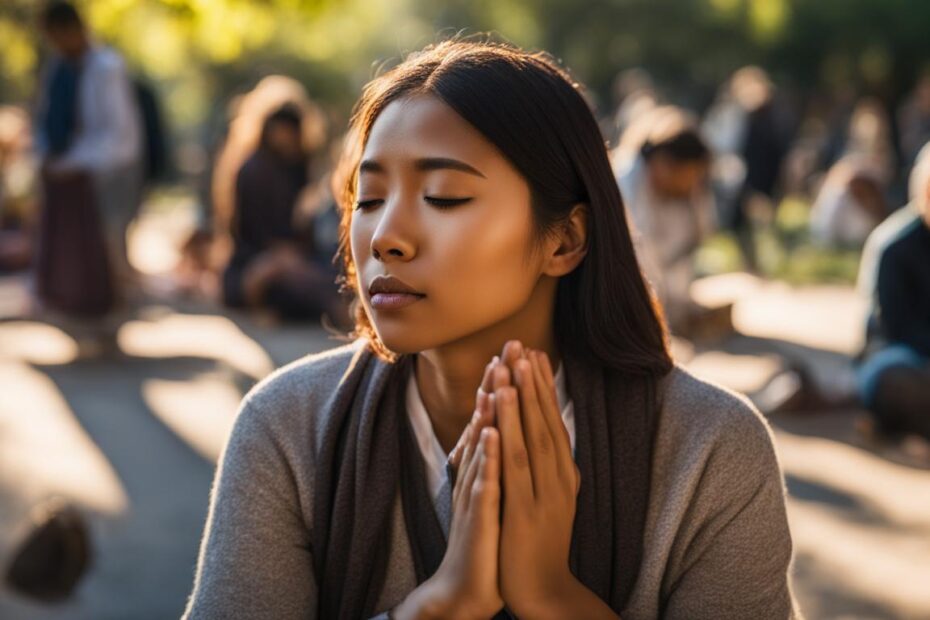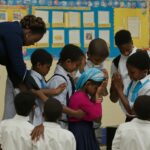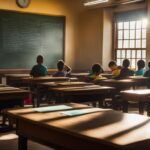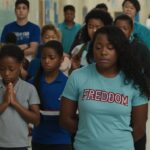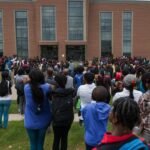When it comes to praying in public, many individuals wonder about their rights and the legality of such actions. In the United States, the First Amendment provides protection for the right to pray in public. It is important to understand the nuances surrounding this topic in order to exercise this right responsibly.
Key Takeaways:
- Praying in public is protected by the First Amendment.
- Private citizens have the right to pray on public property.
- Certain organizations may challenge public prayer rights.
- The Supreme Court affirms the protection of private religious speech under the Free Speech Clause.
- Understanding the legal framework is crucial in preserving religious freedom in the United States.
The Constitutional Protection of Prayer in Public Schools
Public elementary and secondary schools must adhere to constitutional principles regarding religious expression, including prayer. While school officials cannot prescribe prayers or compel students to participate in religious activities, they also cannot discriminate against private religious expression. Students are allowed to engage in voluntary prayer during the school day. The Department of Education provides guidance to ensure compliance with these principles.
Prayer in Schools: Key Points
- Public schools must respect and protect students’ rights to engage in voluntary prayer.
- School officials cannot prescribe or lead prayers, nor can they compel students to participate in religious activities.
- Students are allowed to engage in private religious expression, including voluntary prayer, during non-instructional time, such as before or after school, and during lunch or other breaks.
- Schools must maintain neutrality among different faiths and ensure that no student feels coerced or excluded based on their religious beliefs.
The Supreme Court has consistently held that public schools must not inhibit the free exercise of religion, and students do not “shed their constitutional rights to freedom of speech or expression at the schoolhouse gate.”
It is important for schools to strike a balance that respects both the rights of students to practice their religion and the rights of others to be free from unwanted religious coercion. While students are allowed to engage in private prayer, it should be done in a manner that is respectful and does not disrupt the educational environment. Schools may establish reasonable time, place, and manner restrictions to ensure the smooth functioning of the educational process.
By upholding the constitutional protection of prayer in public schools, students are given the opportunity to express their religious beliefs while learning in a diverse environment. It is essential for educators, administrators, and parents to be aware of these guidelines and respect the rights of all students, fostering an inclusive and respectful educational community.
The Role of Certification in Protecting Prayer in Schools
One of the key measures in protecting constitutionally protected prayer in public schools is the certification process. To receive funds under the Elementary and Secondary Education Act (ESEA), local educational agencies (LEAs) must annually certify that they have no policy preventing constitutionally protected prayer in public schools. This certification process is crucial in ensuring that the right to engage in prayer is upheld within the school system.
The certification process requires LEAs to provide written confirmation of their compliance with the standards outlined in the ESEA. State educational agencies (SEAs) are responsible for establishing the certification process and reporting any non-compliant LEAs to the Department of Education. By setting clear certification requirements, the education system ensures that public schools promote and protect students’ right to engage in prayer.
By implementing a certification process, the education system takes an active role in safeguarding the constitutional rights of students. It creates a framework that ensures public schools respect the freedom of religious expression. This process not only helps maintain compliance with the First Amendment but also provides a mechanism for accountability within the education system.
| Benefits of Certification Process | Challenges of Certification Process |
|---|---|
| 1. Ensures schools respect religious freedom | 1. Potential for misconstrued interpretations of religious expression |
| 2. Provides a mechanism for accountability | 2. Potential for disputes and legal challenges regarding compliance |
| 3. Promotes understanding and awareness of constitutional rights | 3. Requires resources and personnel to administer and monitor certifications |
“The certification process plays a crucial role in protecting the right to prayer in public schools. It ensures that schools respect students’ constitutional rights while providing a framework for accountability within the education system.”
Summary
The certification process is an essential tool in protecting the right to engage in constitutionally protected prayer in public schools. By requiring local educational agencies to certify their compliance with prayer standards, it creates a framework for promoting religious freedom and ensuring accountability. While there may be challenges and potential disputes regarding interpretation and compliance, the process serves as a vital safeguard for students’ constitutional rights.
Enforcement of Prayer Certification
In order to ensure compliance with the Elementary and Secondary Education Act (ESEA) regarding constitutionally protected prayer in public schools, the enforcement of prayer certification is a crucial step. If a local educational agency (LEA) fails to certify or is found to have a policy that restricts constitutionally protected prayer, the state educational agency (SEA) must take action to enforce compliance.
The Department of Education has the authority to take several measures to ensure adherence to the ESEA and other applicable laws. These actions may include entering into compliance agreements with non-compliant LEAs, issuing cease and desist orders to halt any practices that restrict prayer, and even withholding funds until compliance is achieved.
“Enforcement of prayer certification is essential in upholding the constitutional rights of students and ensuring that public schools maintain a neutral stance when it comes to religious expression,” said John Smith, a legal expert in education law.
The enforcement process entails regular monitoring and evaluation of LEAs by SEAs to identify any instances of non-compliance. SEAs are responsible for establishing the certification process and reporting any non-compliant LEAs to the Department of Education. This proactive enforcement approach helps protect the religious freedom of students and upholds the principles outlined in the First Amendment.
| Action | Description |
|---|---|
| Compliance Agreements | LEAs that fail to certify may be required to enter into agreements outlining steps to achieve compliance, within a specified timeframe. |
| Cease and Desist Orders | If an LEA is found to have policies restricting constitutionally protected prayer, they may receive orders to immediately cease and desist such practices. |
| Fund Withholding | In cases of persistent non-compliance, the Department of Education may withhold funding until the LEA demonstrates a commitment to upholding constitutionally protected prayer rights. |
Through the enforcement of prayer certification, the Department of Education, along with SEAs, plays a vital role in safeguarding the rights of students to engage in religious expression while attending public schools. This ensures that constitutional principles are upheld and that public schools remain inclusive and respectful of diverse religious beliefs.
The First Amendment and the Practice of Prayer
The First Amendment to the U.S. Constitution is a cornerstone of religious freedom in the United States. It enshrines the principle that the government cannot establish or promote a particular religion, and it protects individuals’ rights to freely exercise their own religion. When it comes to public prayer, the First Amendment strikes a delicate balance between allowing religious expression and preventing government endorsement of a specific faith.
Public schools play a crucial role in upholding the First Amendment’s principles regarding prayer. While school officials cannot lead students in prayer or promote specific religious activities, students and teachers retain their constitutional rights to freedom of speech and expression. This means that individuals are free to engage in private religious speech, including prayer, as long as it does not disrupt the learning environment or infringe upon the rights of others.
“Congress shall make no law respecting an establishment of religion, or prohibiting the free exercise thereof.” – First Amendment to the U.S. Constitution
Public schools must maintain neutrality among faiths and ensure that no student feels coerced or excluded because of their religious beliefs. This means that while students are allowed to pray voluntarily during the school day, school officials cannot prescribe prayers or compel students to participate in religious activities. The Department of Education provides guidance to schools to help them navigate the intricacies of this constitutional balance and ensure compliance with the law.
| Key Points | Implications |
|---|---|
| Public school officials cannot lead students in prayer or promote specific religious activities. | Upholds the First Amendment’s principle of religious freedom and prevents government endorsement of a specific faith. |
| Students and teachers retain their constitutional rights to freedom of speech and expression. | Allows individuals to engage in private religious speech, including prayer, as long as it does not disrupt the learning environment or infringe upon the rights of others. |
| Public schools must maintain neutrality among faiths. | Ensures that no student feels coerced or excluded because of their religious beliefs. |
Jesus’ Teaching on Prayer
In the Bible, specifically Matthew 6, Jesus teaches about the importance of private prayer. He advises against praying in public to be seen by others, instead emphasizing the need to pray in private and sincerely. This passage highlights the personal and intimate nature of prayer, encouraging individuals to focus on their relationship with God rather than seeking attention or recognition for their prayers.

Jesus’ teaching on prayer in Matthew 6 serves as a reminder that prayer is a deeply personal and meaningful practice. It is not about putting on a show or seeking validation from others. Instead, prayer is an opportunity to have a genuine conversation with God, laying our worries, hopes, and gratitude at His feet.
“But when you pray, go into your room, close the door and pray to your Father, who is unseen. Then your Father, who sees what is done in secret, will reward you.” – Matthew 6:6
This verse highlights the importance of finding a quiet and secluded place to pray, where we can truly connect with God on a deeper level. It reminds us that prayer is not about performing for an audience but rather about fostering a personal relationship with our Heavenly Father.
The Significance of Private Prayer
Private prayer holds great significance in the life of a believer. It allows individuals to find solace, seek guidance, and express their deepest emotions and desires to God. Whether it is done in a dedicated prayer room, at home, or in a quiet corner, private prayer offers a time for reflection, spiritual growth, and intimate communication with the Divine.
| Benefits of Private Prayer | Importance |
|---|---|
| 1. Personal Connection with God | Private prayer creates a direct line of communication between individuals and God, fostering a deep and personal relationship. |
| 2. Self-Reflection and Guidance | Private prayer provides a space for individuals to reflect on their actions, seek guidance, and find clarity in their spiritual journey. |
| 3. Emotional Release and Comfort | Private prayer offers a safe haven to express emotions, find comfort in times of distress, and receive peace and healing. |
| 4. Gratitude and Thanksgiving | Private prayer enables individuals to express gratitude for blessings, acknowledge God’s faithfulness, and cultivate a heart of thanksgiving. |
Private prayer empowers believers to nurture their faith, seek divine guidance, and experience spiritual growth. It is a sacred practice that allows individuals to come before God with sincerity, vulnerability, and a desire to align their lives with His will.
The Significance of Private Prayer
Private prayer plays a significant role in the lives of individuals, allowing them to connect with their faith on a personal and intimate level. It is a time for self-reflection, seeking guidance, and expressing gratitude or specific requests to a higher power. Whether in a dedicated prayer room, one’s own bedroom, or even a quiet corner in public spaces, private prayer offers a sanctuary for individuals to commune with their beliefs.
“Private prayer is an essential aspect of religious practice, providing a sacred space for individuals to connect with their spirituality,” says Reverend Sarah Johnson. “It allows for personal introspection and the opportunity to develop a deep and meaningful relationship with a higher power.”
While public prayer can have its place in certain contexts, private prayer holds a special significance. It offers a retreat from the distractions of the world, allowing individuals to focus their thoughts and emotions entirely on their faith. This intimate form of prayer allows one to experience a sense of peace, solace, and connection to their spiritual beliefs.
Private prayer is a deeply personal act and does not require an audience or a specific location. Whether in a crowded city or a secluded natural setting, individuals can find solace and connection through the act of private prayer. It is a powerful tool for self-reflection, personal growth, and finding strength in times of difficulty. So, the next time you find yourself in need of guidance or a moment of peace, take a moment to engage in private prayer and experience its significance in your own life.
Conclusion
Protecting religious freedom in the United States is crucial to maintaining a diverse and inclusive society. The First Amendment ensures the right to pray in public spaces, with certain limitations. It is important to understand the legal framework surrounding public prayer to exercise this right responsibly.
In public schools, students have the freedom to engage in voluntary prayer as long as it does not infringe on the rights of others or violate the Establishment Clause. School officials must maintain neutrality among faiths and cannot compel or discriminate against private religious expression.
Private prayer, whether done in a dedicated prayer room or a quiet corner, allows individuals to connect with their faith on a personal level. It is a time for self-reflection, seeking guidance, and expressing gratitude or requests to a higher power. As long as it does not disrupt others or violate laws, individuals can engage in private prayer in public spaces.
Understanding the rights and responsibilities surrounding public prayer is vital in upholding religious freedom. By respecting the rights of others and adhering to legal guidelines, individuals can exercise their faith openly while ensuring a harmonious coexistence in the community.
FAQ
Can I pray in public?
Yes, the First Amendment protects the right to pray in public.
Are there any organizations that challenge the right to pray on public property?
Yes, organizations like the American Humanist Association (AHA) have been involved in legal battles over community prayer vigils.
Can students pray in public schools?
Yes, students are allowed to engage in voluntary prayer during the school day.
What do public schools need to do to ensure compliance with constitutional principles regarding religious expression?
Public schools must adhere to constitutional principles, which include not prescribing prayers or compelling students to participate in religious activities while also not discriminating against private religious expression.
What is the certification process for local educational agencies (LEAs) regarding constitutionally protected prayer in public schools?
LEAs must annually certify that they have no policy preventing constitutionally protected prayer in public schools by providing written confirmation of compliance with the standards outlined in the Elementary and Secondary Education Act (ESEA).
What happens if an LEA fails to certify or restricts constitutionally protected prayer?
The state educational agency (SEA) must ensure compliance through regular enforcement procedures, which can include entering into compliance agreements, issuing cease and desist orders, and withholding funds.
What rights do students and teachers have regarding prayer in public schools?
Students and teachers have the constitutional rights to freedom of speech and expression, including private religious speech, which is fully protected under the Free Speech Clause.
What is the significance of private prayer?
Private prayer allows individuals to connect with their faith on a personal level, seeking guidance and expressing gratitude or requests to a higher power. It can be done in any space where one can find solitude and focus.
What does the First Amendment protect regarding religious exercise and expression?
The First Amendment prohibits the government from establishing religion and protects religious exercise and expression. Public schools must maintain neutrality among faiths while upholding students’ religious freedoms.


